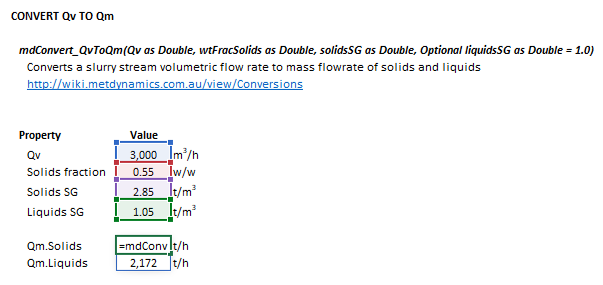Conversions: Difference between revisions
imported>Scott.Munro m (→Model theory) |
imported>Scott.Munro |
||
| Line 39: | Line 39: | ||
The retained to cumulative passing method may be invoked from the Excel formula bar with the following function calls: | The retained to cumulative passing method may be invoked from the Excel formula bar with the following function calls: | ||
<syntaxhighlight lang="vb">=mdConvert_RetToCumPass(Retained as Range)</syntaxhighlight> | <syntaxhighlight lang="vb">=mdConvert_RetToCumPass(Retained as Range, Optional quantityPassing as Bool = false)</syntaxhighlight> | ||
{{Excel (Text, Help, No Arguments)}} | {{Excel (Text, Help, No Arguments)}} | ||
| Line 76: | Line 76: | ||
* <math>p</math> is the quantity retained on size interval <math>i</math> (<math>1 \leq i \leq n</math>) | * <math>p</math> is the quantity retained on size interval <math>i</math> (<math>1 \leq i \leq n</math>) | ||
* <math>P</math> is the cumulative quantity passing size interval <math>i</math> | * <math>P</math> is the cumulative quantity passing size interval <math>i</math> | ||
* <math>\mathit{quantityPassing}</math> is an optional flag that indicates whether to return the quantity passing instead of the fraction, (''True/False'') | |||
|} | |} | ||
| | | | ||
Revision as of 07:05, 11 October 2023
Description
This article describes methods for converting:
- Weight fraction retained to cumulative fraction passing particle size distributions
- Cumulative fraction passing to weight fraction retained particle size distributions
- Particle size distributions between different mesh series
- Particle size distribution mesh interval sizes to geometric mean sizes
- Volumetric flow rates of slurry to mass flow rates of solids and liquids
Model theory
Geometric mean size
The geometric mean size of a particle, (mm), is defined as:
where:
- is the index of the size interval,
- is the number of size intervals
- is the diameter of particles retained in a mesh at size interval (mm)
- the value of decreases as increases, i.e. , = top size,
Excel
Retained to cumulative passing
The retained to cumulative passing method may be invoked from the Excel formula bar with the following function calls:
=mdConvert_RetToCumPass(Retained as Range, Optional quantityPassing as Bool = false)
Invoking the function with no arguments will print Help text associated with the model, including a link to this page.
The input parameters and calculation results are defined below in matrix notation, along with an example image showing the selection of the same cells and arrays in the Excel interface:
|
| ||||
Cumulative passing to retained
The cumulative passing to retained method may be invoked from the Excel formula bar with the following function calls:
=mdConvert_CumPassToRet(CumPassing as Range)
Invoking the function with no arguments will print Help text associated with the model, including a link to this page.
The input parameters and calculation results are defined below in matrix notation, along with an example image showing the selection of the same cells and arrays in the Excel interface:
|
| ||||
Convert between meshes
The convert between meshes method may be invoked from the Excel formula bar with the following function calls:
=mdConvert_ToMesh(Size1 as Range, Dist1 as Range, Size2 as Range, Optional axesScale as Integer = 0, Optional interpMethod as Integer = 0)
Invoking the function with no arguments will print Help text associated with the model, including a link to this page.
The input parameters and calculation results are defined below in matrix notation, along with an example image showing the selection of the same cells and arrays in the Excel interface:
|
| ||||
Geometric mean size
The geometric mean size method may be invoked from the Excel formula bar with the following function calls:
=mdConvert_ToGeoMeanSize(Size as Range)
Invoking the function with no arguments will print Help text associated with the model, including a link to this page.
The input parameters and calculation results are defined below in matrix notation, along with an example image showing the selection of the same cells and arrays in the Excel interface:
|
| ||||
Slurry volume flow to mass flow
The slurry volume flow to mass flow method may be invoked from the Excel formula bar with the following function calls:
=mdConvert_QvToQm(Qv as Double, wtFracSolids as Double, solidsSG as Double, Optional liquidsSG as Double = 1)
Invoking the function with no arguments will print Help text associated with the model, including a link to this page.
The input parameters and calculation results are defined below in matrix notation, along with an example image showing the selection of the same cells and arrays in the Excel interface:
|
| ||||















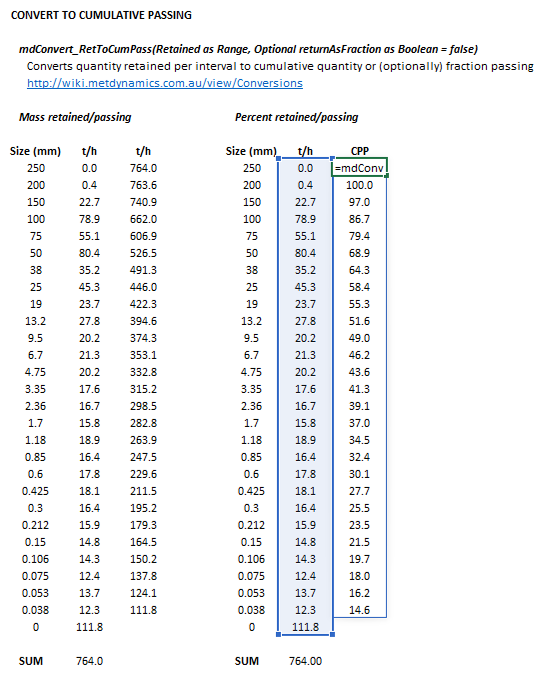


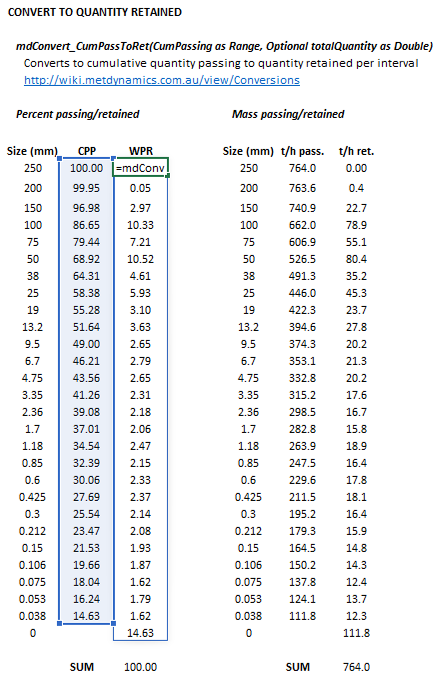
![{\displaystyle {\begin{aligned}{\mathit {Size1}}&={\begin{bmatrix}d_{1}{\text{ (mm)}}\\\vdots \\d_{n}{\text{ (mm)}}\\\end{bmatrix}}\\\\{\mathit {Dist1}}&={\begin{bmatrix}p_{1}\\\vdots \\p_{n}\\\end{bmatrix}}\\\\{\mathit {Size2}}&={\begin{bmatrix}d_{1}{\text{ (mm)}}\\\vdots \\d_{m}{\text{ (mm)}}\\\end{bmatrix}}\\\\{\mathit {axesScale}}&={\big [}{\text{(0, 1 or 2)}}{\big ]}\\\\{\mathit {interpMethod}}&={\big [}{\text{(0 or 1)}}{\big ]}\\\end{aligned}}}](https://wikimedia.org/api/rest_v1/media/math/render/svg/f31f2058f2616807d28c52f195d093521bf4fafd)





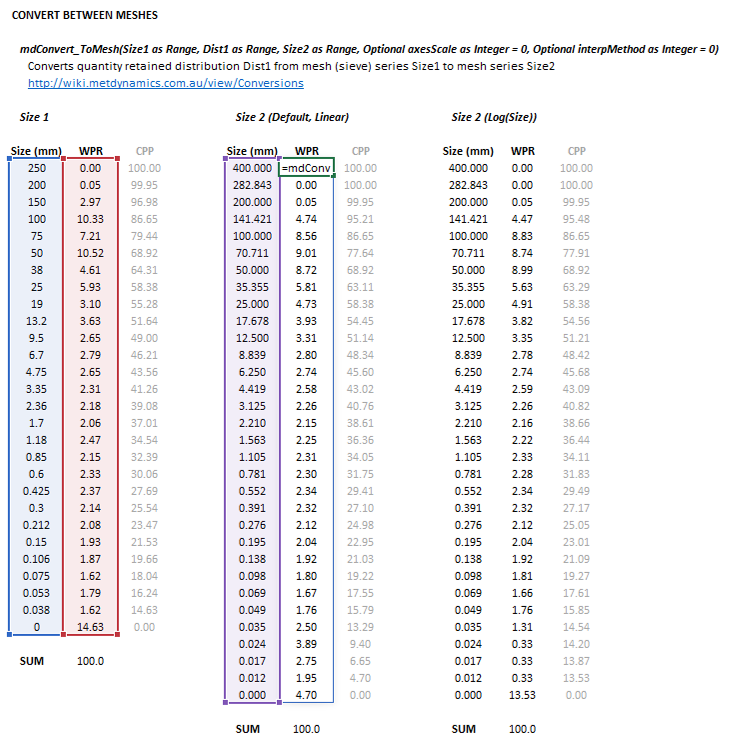


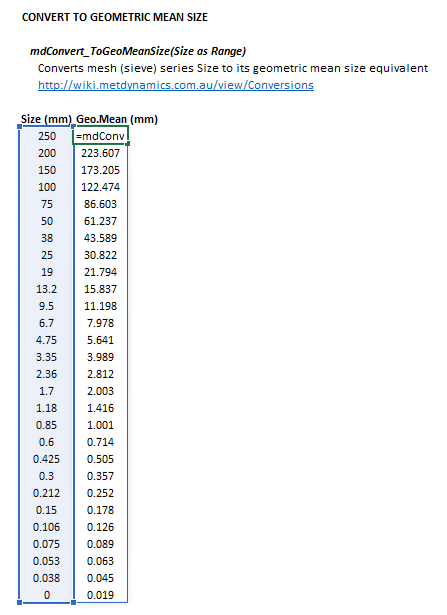
![{\displaystyle {\begin{aligned}{\mathit {Qv}}&={\big [}Q_{\rm {V}}{\text{ (m}}^{3}{\text{/h)}}{\big ]}\\\\{\mathit {wtFracSolids}}&={\big [}C_{\rm {W}}{\text{ (w/w)}}{\big ]}\\\\{\mathit {solidsSG}}&={\big [}\rho _{\rm {S}}{\text{ (t/m}}^{3}{\text{)}}{\big ]}\\\\{\mathit {liquidsSG}}&={\big [}\rho _{\rm {L}}{\text{ (t/m}}^{3}{\text{)}}{\big ]}\\\end{aligned}}}](https://wikimedia.org/api/rest_v1/media/math/render/svg/4dee13de46d7b1910de710bd333974bf1f88cdf9)







